#Women in war
Explore tagged Tumblr posts
Text
Defending the castle like a man...
I've just read this article : Defending the castle like a man: on belligerent medieval ladies.
One of my friend is practicing HEMA (historical european martial art) as well as forging. We speak often about it and I have many question, mostly because of my main character in my medieval romance. As in forging, strength is not all in fighting. Know how to do it and practicing is first and foremost (she is smaller and thinner than me. she can wield swords that I cannot lift).
She reads lots of things about medieval warfare and we have discussion about it, and more recently because of my main character in my medieval romance. She had send me this article. And while reading it, I thought about some of my mutuals and the quite recent discussion about Eowyn and Théoden. So this is for you : @torchwood-99 , @from-the-coffee-shop-in-edoras , @konartiste. @errruvande I thought about you as there is a good reference about Alfred's daughter.
Reading this, I thought about Théoden. Rohan seems to have a certain history of female fighters. Shieldmaiden is not a name coming out of nowhere. So... what led Rohan to, seemingly, forget about this role? When did it happen?
In this article, there are a lot of example of women who did fight in war and defend their territory. It seems there are more and more proof of that. Even more, it seems women were actually expected to know at least how to defend their castle and lands. "Do as their husband do". So they had to know how to fight or at least strategies and siege... And some knew how to use bows, crossbows and even swords. Still, they had been, most of the time, erased or played down.
It is not said if this erasing was all along or more recent, as it is noted that those women of war were common up until the 14th centuries. In any case, they existed, but in later ages, it was inconvenient for men to have their female kin show "men's virtue".
Did something equivalent happened in Rohan? Why would something like this would happen? I would be the first to say "Oh it's all Saruman/Grima's fault". But no. Theoden do not think of sending Eowyn to war. He does not even have the reflex to think about her as a leader for his people. if it had been Grima and/or Saruman, he would have think about it.
Could it be his gondorian upbringing? After all he grew up in Gondor, had a gondorian mother? Thengel did not seem to held his countries culture in high regard. So, could it be this? Or even before that?
In my glèomenn fanfic, Tirwald said it was legends and old story. Could it be even older? Something more recent, linked to another culture?
So... What do you think?
#lord of the rings#lotr#musing#Eowyn#Theoden#Shieldmaiden#women in war#medieval women and warfare#emma's writing#medieval romance#article#Defending the Castle like a man
58 notes
·
View notes
Text

Brienne of Tarth
(I had to draw her in chainmail, and in pink and blue. You know why)



#brienne of tarth#joan of arc#leelee sobieski#jean seberg#ingrid bergman#joan d'arc#women in war#bitterbridge?
112 notes
·
View notes
Text



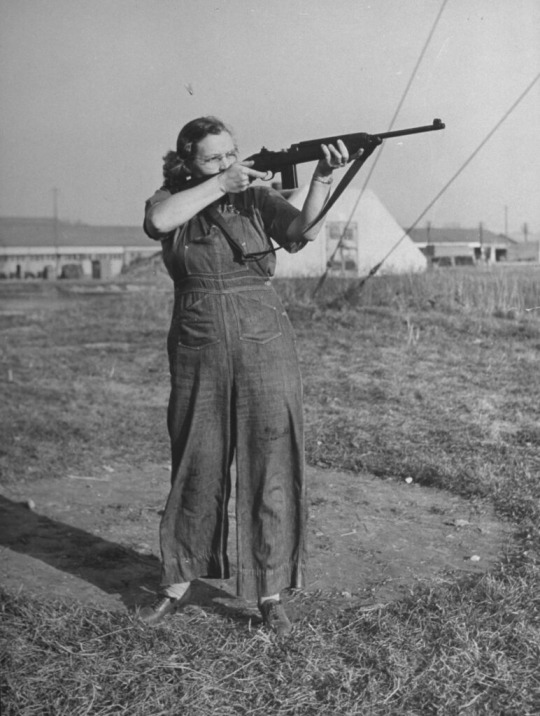



Women testing weapons at Aberdeen Proving Ground in Maryland, 1942.
Photographed by Bernard Hoffman and Myron Davis for the February 1, 1943 issue of LIFE Magazine.
"The women come from everywhere. Many have husbands in the Army. Others have husbands who also work at Aberdeen. They wear bright-colored slacks, and their ‘firing fronts’ are a rippling blend of pink, blue and orange, mixed with white and black powder from the guns. They serve on crews of all weapons up to the 90mm A.A.’s [anti-aircraft guns]. They handle highly technical instruments. They drive trucks, act as bicycle messengers, swab and clean vehicles."
#women#old photos#1940s#mine#feminism#life magazine#bernard hoffman#myron davis#women in history#artillery#guns#wwii#wwii history#historic photographs#vintage#history#world war ii#women in war#40s#world war 2#photography#old photography#black and white photography#b&w photography#war photography#war history#b&w#black and white
136 notes
·
View notes
Text
Milunka Savić, the Most Decorated Female Combatant in History: Savić disguised herself as a man in order to join the Serbian army during the Balkan Wars, then served again during WWI, earning medals from Serbia, France, Russia & Britain; she also provided medical support to anti-fascists during WWII and spent 10 months in a Nazi concentration camp
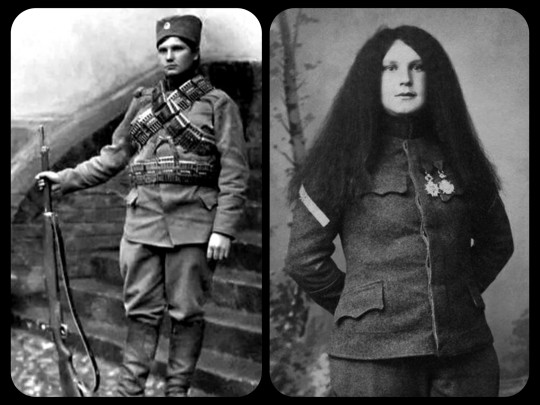
This is a total rewrite of a post that I did last year, with much more detailed information, more photos, and some additional sources.
Milunka Savić is regarded as the most decorated female combatant in history. She fought for the Serbian Army during both of the Balkan Wars, before returning to the battlefield again during WWI. Savić was wounded in battle on 9 separate occasions and survived the Serbian Great Retreat, making the perilous journey across the mountains of Montenegro and Albania through the dead of winter with a serious head injury.
Her military career began during the First Balkan War in 1912, when her younger brother was called up to serve in the Serbian army, and she decided that she would covertly take his place. She cut her hair, wore men's clothing, and presented herself as her brother.

The First Balkan War, 1912: Milunka Savić as a young soldier during the First Balkan War, shortly after joining the Serbian army
She was able to hide her true identity for quite some time. Her skills as a soldier quickly became evident as the war progressed, and she earned her first medal/promotion during the Battle of Bregalnica in 1913. Unfortunately, she was hit by shrapnel from a Bulgarian grenade during her tenth deployment, causing injuries to her chest and abdomen, and those wounds (along with the subsequent medical treatment) ultimately led to the discovery that she had lied about her identity.
In recognition of her accomplishments on the battlefield, her commanding officer decided not to punish her for the initial deception, but informed her that she would not be allowed to return to combat -- as a woman, she could only be transferred to the nursing division instead.
As the story goes:
Savić was called before her commanding officer. They didn't want to punish her, because she had proven a valuable and highly competent soldier, and the military deployment that had resulted in her [sex] being revealed had been her tenth; but neither was it suitable for a young woman to serve in combat. She was offered a transfer to the Nursing division. Savić stood at attention and insisted that she only wanted to fight for her country as a combatant.
The officer said he'd think it over and give her his answer the next day. Still standing at attention, Savić responded, "I will wait." It is said he only made her stand an hour before agreeing to send her back to the infantry.
Savić was able to serve in a combat role throughout the remainder of the Balkan Wars.
The Second Balkan War finally came to an end in 1913, but that peace was short-lived, as World War I erupted just a year later. Savić returned to the military once more, serving in the elite "Iron Regiment" of the Serbian army.
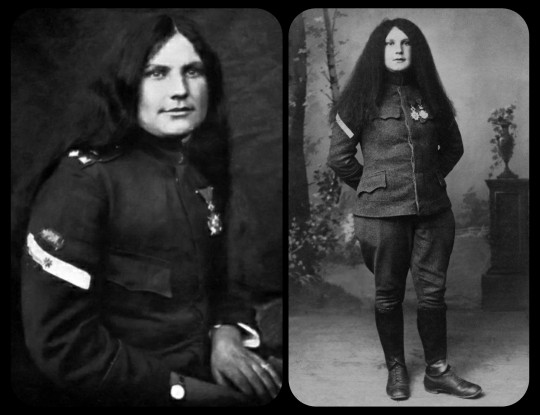
World War I, c.1915-1916: Savić was no longer forced to hide her identity when she returned to battle during WWI, and these images show her posing in uniform with her hair grown out
Savić received the Serbian Karađorđe Star with Swords medal on two separate occasions during WWI; the second medal was given to her after the Battle of Crna Bend in 1916, where she was credited with single-handedly capturing 23 Bulgarian soldiers. She received several other medals throughout the course of her career, including the French Legion of Honor (twice), the French Croix de Guerre, the Russian Cross of St. George, the British Medal of the Most Distinguished Order of St. Michael, and the Serbian Miloš Obilić.
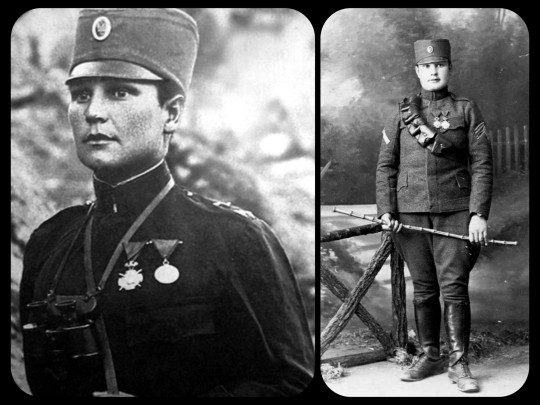
WWI, c.1915-1916: Milunka Savić as a Corporal in the Iron Regiment
She suffered a serious head injury while fighting along the Macedonian front, and she was still gravely wounded when Austro-Hungarian, German, and Bulgarian forces gained control of Serbia in the winter of 1915. The Serbian army was then ordered to make a full retreat from Serbia; Savić and her fellow soldiers, along with the Serbian government and more than 200,000 civilians, were all forced to flee through the mountains of Montenegro and Albania in the dead of winter, hoping to reach Allied forces along the Adriatic Coast -- a perilous journey that would later be known as the Serbian Great Retreat (or the Albanian Golgotha). Roughly 400,000 people embarked on this journey, and less than 180,000 of them survived, eventually reaching the Allied ships along the Adriatic coast.
Despite her injuries, Milunka Savić was among the survivors. She was sent to an infirmary, where she spent several months recovering from her injuries, before she returned to the battlefield alongside Allied forces.
At the end of the war, the French government offered to provide Savić with a full pension and living accommodations in France, in recognition of her actions while serving alongside the French military during WWI. She ultimately declined the offer and chose to retire back in Serbia instead, where she and her husband settled down to raise their daughter and three other girls that Milunka had adopted. The couple would later separate, however, and Milunka was left to raise her children as a single mother, working at a local bank to make ends meet.
In 1941, Serbia (which was then part of Yugoslavia) fell under Nazi occupation. During this period, Savić was involved in providing medical support to local partisans and anti-fascists who had resisted the Nazi occupation. She was eventually arrested by German officers; there are differing accounts of the events leading up to her arrest, with some sources suggesting that she was arrested as a result of her involvement with the local partisans and other anti-fascist elements, while other sources claim that she was arrested after she offended several Nazi officials by openly refusing to attend a formal banquet that was being held in honor of the German military campaign. In any case, she was imprisoned at the infamous Baljinca Concentration Camp for ten months before finally being released.
She faced other forms of hardship in the aftermath of WWII, as she struggled to support herself and her children. She worked several low-paying jobs over the years, while living in a dilapidated, decaying house in Belgrade. Her name (and her long list of accomplishments) had largely faded into obscurity by then.
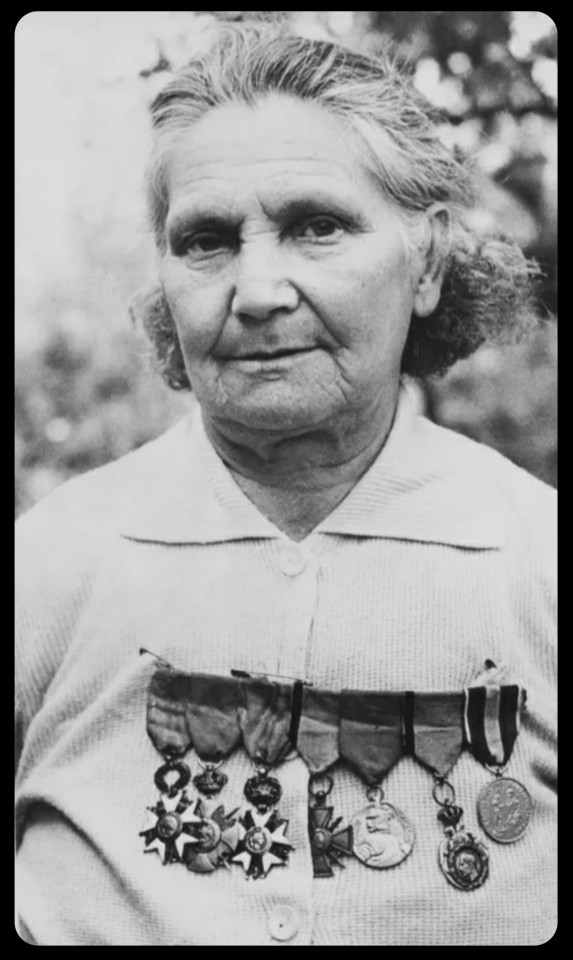
Serbia, 1972: Milunka Savić proudly displaying some of her medals in 1972, when her story became more widely known
It wasn't until the early 1970s that her involvement with the military finally began to receive more widespread attention, both in Serbia and abroad. Following the 1972 publication of an article that told her story, her local community in Belgrade quickly rallied to provide her with newer, more suitable living arrangements.
Sadly, she passed away within just a year of the article's publication.
In 2013, Milunka Savić's remains were relocated from the small mausoleum where they had been interred since 1973, and she was reburied in Belgrade's "Alley of the Greats," where some of the most well-known and most widely respected Serbians are laid to rest.
Sources & More Info:
Research Gate: Milunka Savić: the Forgotten Heroine of Serbia
Girl Museum: Milunka Savić
Law and Politics: The Position of Women in the Serbian Army
Medium: The Fearless Woman-Bomber Who Died Proud, Broke, and Forgotten
Wikipedia: Milunka Savić
Mental Floss: The Serbian "Great Retreat" Begins (WWI Centennial)
#history#Milunka Savić#women in history#serbia#women in the military#balkans#military history#wwii#wwi#yugoslavia#milunka savic#challenging gender norms#feminism#femininity#serbian history#women's liberation#women in war#real-life mulan
63 notes
·
View notes
Text

Women In War Jan 1959 (and Battle Cry Dec 1962)
Victor Prezio
#golden age art#pulp magazine art#pulp art#pulp art 1959#Women In War#Battle Cry#Vic Prezio art#byronrimbaud
124 notes
·
View notes
Text

The American Women’s Voluntary Services began operations on January 4, 1942 at Sixth Avenue and 42nd Street. They ran a mobile kitchen serving hot drinks, doughnuts, and sandwiches to all men in uniform. This being the '40s, cigarettes were handed out, too. Some of the first “customers” are shown taking advantage of the free service.
Photo: Associated Press
#vintage New York#1940s#World War II#home front#Women's Voluntary Services#Jan. 4#4 Jan.#free lunch#women in war#civilians in World War II#AWVS#WVS
103 notes
·
View notes
Text


1. Wars are MAN-made.
2. Women have ALWAYS fought for their country and people, whether by taking care of their home environment & other civilians as much as possible or by actively joining combat, even if men didn’t approve of it and often punished them for it.
3. Women and children are the primary victims when it comes to war crimes such as rape, forced pregnancy, slavery … and they make up the majority of post-war deaths.
4. Women are not only targeted by the intruders, but also by THEIR OWN MALE PEERS.
Any man who whines and complains that "women have it so much better" quite frankly doesn’t deserve any sympathy, and IDGAF what happens to men like that. You either educate yourself, become an ally to women or you merely prove that you‘re expendable AT BEST.
#women deserve better#radfem#radblr#radical feminism#feminism#radfems do touch#radfems do interact#reblog#radfems please touch#womens rights#women in war
188 notes
·
View notes
Text
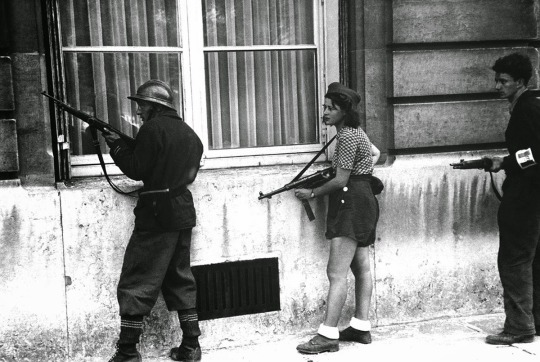

Après son entrée dans Paris avec les troupes de la 2e Division blindée, Simone Segouin, résistante française dans les Francs-tireurs et partisans (FTP), et deux de ses camarades participent à l'élimination des dernières poches de résistance – Libération de Paris – Opération Overlord – Août 1944
Photos Robert Capa
©Magnum photos
Simone Segouin rejoint les Francs-Tireurs et Partisans en 1944 à l'âge de 18 ans sous le pseudonyme de Nicole Minet. Après de nombreuses missions en tant qu'agent de liaison entre Dreux, Chartres et Châteaudun, les FTP lui propose de prendre les armes et devient l'une des rares femmes à prendre part aux combats. Attaques de convois, de trains, de détachements ennemis et opérations de sabotage lui valent le respect au sein de la résistance.
Elle participe activement à la libération de Chartres et s'illustre le 20 août 1944 en prenant part à la capture de 25 allemands à Thivars, à 7 km au sud de Chartres. A cette occasion elle récupère un pistolet mitrailleur MP40 avec lequel elle pose fièrement lors de la venue du Général de Gaulle à Chartres le 23 août pendant sa tournée d'inspection des régions libérées.
A la suite de cette cérémonie, les différents groupes de résistants du département prennent la direction de Paris pour participer aux combats insurrectionnels. La plupart regagnent Paris et font la jonction avec la 2e Division blindée de Leclerc le 25 août à six heures du matin.
C'est la raison pour laquelle, un cliché de Robert Capa présente Simone Segouin aux côtés de deux de ses camarades face aux dernières poches de résistance allemande.
Sa conduite valeureuse dans la clandestinité et son action dans les combats de la Libération lui valurent le grade de sous-lieutenant.
Elle fût décorée de la croix de guerre par Charles Tillon, ministre de l'Armement et ancien chef des FTP le 24 mars 1946 à Chartres.
#WWII#opération overlord#operation overlord#overlord#libération de la france#liberation of france#libération de paris#liberation of paris#résistance#resistance#résistance française#french resistance#francs-tireurs et partisans#ftp#femmes dans la guerre#women in war#figures historiques#historical figures#simone segouin#paris#france#août 1944
39 notes
·
View notes
Text

Laura Knight
Ruby Loftus screwing a Breech-ring
1943
#laura knight#wwii#wwii era#wwii england#women at work#women in war#the home front#factory workers#women artists#women painters#war documentary#british artist#british art#modern art#art history#aesthetictumblr#tumblraesthetic#tumblrpic#tumblrpictures#wwii women#aesthetic#beautiful painting#ruby loftus
122 notes
·
View notes
Link
“In 1919 after the outbreak of the Polish-Soviet war Wanda ‘Kazik’ Gertz became the commander of the 2nd Women’s Volunteer Legion in the Polish army. The legion fought for Vilnius which led to Gertz being awarded the rank of lieutenant as well as the Virtuti Militari medal. She couldn’t enjoy her position for too long though, as in 1922 she lost her lieutenant rank due to the lack of law stating that a woman can be an officer in the Polish army. Afterwards, ‘Kazik’ worked in different fields for 17 years – she worked in an engineering company, in Józef Piłsudski’s office, in the management team of the Belweder Museum etc.
In World War II Gertz created a pseudonym for herself: ‘Lena’, and became one of the first women to join the resistance movement Service for Poland’s Victory. Soon after that, she made history as the first woman to create and command a fully female military unit – ‘DYSK’ unit (Women’s Diversion and Sabotage Unit) as a part of the Polish Home Army. In 1944 she was promoted to the rank of major.”
#history#women in history#wanda gertz#poland#polish history#first world war#second world war#Women in World War II#women in war#20th century#warriors#women's history#female soldiers
19 notes
·
View notes
Note
It is so sad to think how these women passionately wanted to serve their nation only to be betrayed like that by their own people.
God is either dead or a misogynist
Patriotism is largely for maIes no woman is free or seen as a person of the land under a flag.
In regards to your ask though, my money is on both.
13 notes
·
View notes
Text
Follow up discussion on the article about medieval women in war
After a discussion last night with my friend, she told me that, yes, this cover up of the importance of women in actual warfare was a later thing. Mostly linked to a change in ecclesiastial thinking about the place of women. We are looking for the references but it seems, for a long time at least (here I am between 1000 and 1400 AC), women had more freedom: asking divorce if their husband weren't satisfying them, holding lands, going to war. Which align alot with things known for Danes (Viking) women as well.
To answer @celeluwhenfics I did not particularly studied Joan of Arc. While I know about her because you have to study her in french history, I learned much more about the fact she had been a poltical pawn than about her martial prowess. And, in France at least, as she is associated (not really her fault I admit it) with Far Right movement, I was never really interested to learn much more about her...
Beside that, she is also "too far" in time for my research interest. For my medieval romance I am looking at women in war around 1000-1100 AC.
@firelightinferno I've read a bit about Boudica. I didn't know there have been a tentative of erasing her. When I looked at women in war, she is always one of the first to pop in my research, with Joan of Arc as it is. I've seen many paintings about her and I know she became a figure of interest in late... I think Victorian England (I might be wrong though on this one). I was asking if you had references about her as most of the thing I've read were romanticized text, collection of late "historian" who often write with their own agenda in mind.
But, once again, I never went further with Boudica because, this time, she was earlier than the period I am reading about. So I would welcome any article about her.
I have found other articles on medieval women in war, written either by HEMA practitioner or social researcher. So I might share other articles here.
Thanks again for following me in this! It is a very interesting discussion!
14 notes
·
View notes
Text
Nicola Trahan, who has died aged 97, joined the French resistance as a schoolgirl and was awarded the Croix de Guerre avec Palme for her bravery during “numerous dangerous missions”, in particular a series of battles between her Maquis and the notorious 2nd SS Panzerdivision Das Reich. After the second world war she settled in the UK, where she served with the Soldiers’, Sailors’ and Airmen’s Families Association (SSAFA) for 50 years.
Aged 16, while still at school in Valençay, Indre, in central France, she joined the Forces Françaises de l’Intérieur (FFI), the resistance organisation run by the Gaullist French authorities in London and known as the Armée Secrète.
According to her French military file, Trahan became a member of the North Indre Maquis, led by Francis Perdriset, a former French army officer who took charge of FFI resistance operations in that area in July 1943. Her main role was as a courier delivering messages twice daily between the various resistance teams.
She also worked as part of the Maquis’ medical team and, amid a heavy German military presence, used her trips cycling between the teams to collect intelligence. A note in a file has one resistance fighter telling another that Trahan would sometimes be late because she liked to sit by the road watching the Germans while eating her lunch. “Don’t worry,” he said. “It provides us with valuable information.”
In an interview with a French newspaper following the liberation of France, Trahan said that once when she was stopped by the Germans she screwed up her FFI identity pass into a ball and swallowed it to avoid arrest. She also recalled taking part in firefights and on one occasion shooting and wounding two German soldiers: “I really liked ambushes; when we put together a team and went off in full truckloads. I had a revolver and a machine gun.”
In July 1944, Perdriset and his Maquis began working closely with a British Special Operations Executive (SOE) officer Pearl Witherington (later Cornioley), who was also based in North Indre.
Witherington had set up the SOE’s Wrestler circuit in May that year. But on 11 June, five days after the D-day landings, she and the small number of resistance fighters she had assembled were attacked by a much larger German force. They fought them off but Witherington decided she needed an experienced military officer to help her to reorganise her forces.
“Finally, on 25 July [1944], after I had asked repeatedly for a military commander, to my great relief one arrived,” she recalled in her memoirs. “He was an army captain called Francis Perdriset.”
From that point on, the North Indre Maquis was closely integrated with the SOE Wrestler team. Trahan recalled meeting Witherington once, at a parachute drop of weapons and other supplies, where resistance members would have been called upon to remove the supplies to a safe location.
Shortly after Perdriset took over as Witherington’s military commander, elements of the German 2nd SS Panzerdivision Das Reich arrived in the region on their way north to Normandy, having been ordered to destroy the resistance along the way.
They had previously massacred an entire village at Oradour-sur-Glane and, from mid-August, launched a series of attacks against resistance groups in the Indre area, most notably in Valençay itself, where Perdriset was present.
“The Germans did a lot of damage in Valençay,” Witherington recalled. “I wasn’t there but Francis was. He was told to stand against a wall, he really thought he had had it. The Germans set fire to things, shot, killed. It wasn’t as bad as Oradour-sur-Glane but it wasn’t a pretty sight.”
In his recommendation for the award of the Croix de Guerre, Perdriset said Trahan, then only 17, “notably distinguished herself at Valençay from 20 to 30 August 1944 by bringing her commander valuable information which she gathered at the heart of enemy operations”.
Born Nicole in Berck-sur-Mer, in the Pas de Calais, she was the daughter of André Trahan, who worked in the insurance industry, and Jeanne (nee Bourzes), a professor of English.
Nicole initially boarded at the Collège Cévenol at Le Chambon-sur-Lignon in south-central France. She later recalled that her parents took her to the UK when the Germans occupied northern France in 1940, but by 1942 she was at Cours Guynemer, a private school in Valençay.
After the war, Trahan went to the Sorbonne to study philosophy but, having decided that it was not for her, she trained as a nurse at the Ecole d’Infirmières des Associations Diaconesses in Paris, and at Brighton General hospital, in East Sussex, qualifying in 1953. She subsequently worked as a health visitor in Cheshire. She anglicised her name from Nicole to Nicola and was naturalised British in 1957.
The following year she joined SSAFA, first as a member of its nursing service, then as a health visitor working with service families in Germany, Belgium and Hong Kong. Trahan served with the association for 30 years and after retirement continued to work for them as a volunteer for a further 20 years.
Trahan settled in Orcheston, Wiltshire, where she was also a volunteer at Salisbury Cathedral, and enjoyed swimming and walking her dog.
In 2005, she was invited to the unveiling by Queen Elizabeth II of the monument in Whitehall to The Women of World War II, followed by a lunch for female veterans at Buckingham Palace. In 2008 she was appointed MBE.
Nicola (Nicole) Marie Pauline Trahan, resistance fighter and nurse, born 21 December 1926; died 18 January 2024
15 notes
·
View notes
Text
Defenders of Ukraine
Defender of Ukraine Dementra camouflages her assault rifle.
#ukraine#russia#russian war on ukraine#Dementra#women warriors#women in combat#women in war#assault rifle#assault weapons#war#world at war#weapons
48 notes
·
View notes
Text
Happy Birthday US Navy!
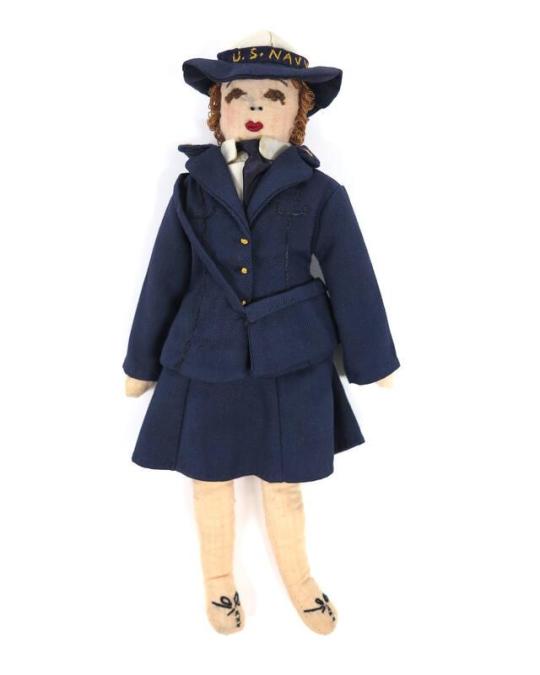
Happy 246th Birthday to the United States Navy!
The WAVES (Women Accepted for Volunteer Emergency Service) played an integral role in the Navy during WWII, taking on a wide range of duties from clerical work to aviation mechanics, aircraft navigation, and code breaking.
Ina McGee of Fitzgerald, GA, made this doll as a Christmas gift for Franklin Roosevelt. She sent it to the White House in December 1944: https://fdr.artifacts.archives.gov/objects/2991/wave-armed-service-doll
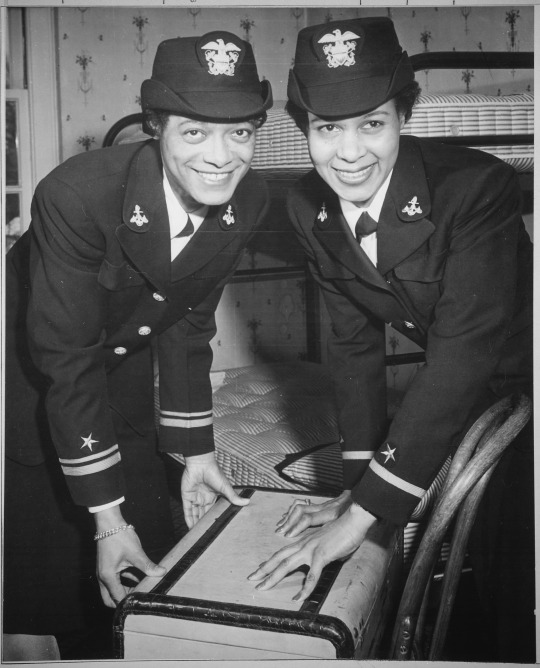
On December 26, 1944, Harriet Pickens and Frances Wills became the first female African American officers in the US Navy: https://catalog.archives.gov/id/520670
16 notes
·
View notes
Text




W.A.C - Photos in the shoebox
#this is my aunt Pete#I wish I could have met her#girlhood#womanhood#vintage#ww2 history#ww2#wwii history#wwii#wwii era#vintage photography#vintage pictures#family#ancestry#women in war#history#historic#historical photos#photoblog#portrait#portrait photography#photography#beautiful photos#vintage aesthetic#vintage women#strong women
6 notes
·
View notes